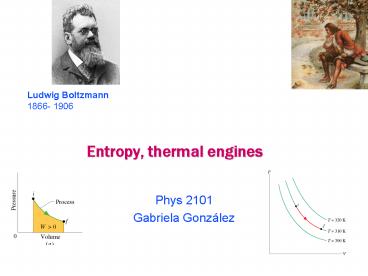Entropy, thermal engines - PowerPoint PPT Presentation
1 / 9
Title:
Entropy, thermal engines
Description:
We can easily tell the direction of the 'arrow of time' in irreversible ... T =Q/T = mLf/T for changes of phase Sw= 0.1kg*4190J/kgK*ln(285.39/293.15) = 11.24 J/K ... – PowerPoint PPT presentation
Number of Views:93
Avg rating:3.0/5.0
Title: Entropy, thermal engines
1
Entropy, thermal engines
- Phys 2101
- Gabriela González
2
Irreversible processes
- We can easily tell the direction of the arrow of
time in irreversible processes which, if
spontaneous, only happen one way - spilling fluids
- gas expansion
- breaking solids
- Conservation of energy doesnt forbid these
processes there is another quantity, entropy,
which measures the degree of disorder - S k log W
3
Second Law of thermodynamics
- If an irreversible process occurs in a closed
system, the entropy S of the system always
increases it never decreases. - If any process occurs in a closed system, the
entropy of the system increases for irreversible
processes and remains constant for reversible
processes. It never decreases! - ??S 0
4
Entropy and heat
5
Example
- An 8.0g ice cube at -10oC is put in a Thermos
flask containing 100 cm3 of water at 20oC. The
specific heat of ice is 2220 J/kgK, the specific
heat of water is 4190 J/kgK, and the heat of
fusion of ice-water is 330 kJ/kg. - Whats the final equilibrium temperature?
- ?Q 0 cWmW(Tf-20oC) cice mice (0oC-(-10oC))
mice Lf cW mice (Tf-0oC) - 0 cw(mwmice)Tf-cwmw20oC cice mice10oC mice
Lf - 41900.108Tf - 41900.120
22200.008100.008330000 - 452.5Tf-8380177.62640 ?Tf 12.24oC 285.39 K
- What is the change in entropy of the ice-water
system? - Use ?S ?dQ/T ?mcdT/T mc ln(Tf/Ti) for
changes in temperature, and - ?S ?dQ/T Q/T mLf/T for changes of phase
- ?Sw 0.1kg4190J/kgKln(285.39/293.15) ?11.24
J/K - ???Sice 8g(4.19J/gKln(285.39/273.15)
2.22J/gKln(273.15/263.15) 330J/g/273.15K)
11.88 J/K - ???S 0.64 J/K
6
Change in Entropy
- Isothermal process
- ?S ?dQ/T (1/T) ?dQ ?Q/TAdiabatic process
?Q0, so ?S0 - Any reversible process,
- dQ dEint dW
- nCV dT p dV
- dQ/T nCV dT/T pdV/T
- nCV dT/T pdV/(pV/nR)
- nCV dT/T nRdV/V
- ?S ?dQ/T
- nCV ln (Tf/Ti) nR ln (Vf/Vi)
- Eint (f/2)nRT n CV T
- W ? p dV
- pV nRT
7
Ideal heat engines
- Ideal heat engines use a cycle of reversible
thermodynamic processes. A heat engine
transforms energy extracted as heat from thermal
reservoirs, into mechanical work. - Consider a Carnot engine a cycle with two
isothermal processes at a high temperature TH
(a?b) and and a low temperature TL (c ?d), and
two adiabatic processes (b?c, d?a). - ?Eint 0 Q W ? W
Q QH-QL - ?S 0
QH/TH - QL/TL
8
Thermal efficiency
- We use the heat QH to get work W done, so
efficiency is defined as - ? W/QH
- For a Carnot engine,
- W QH-QL
- QH/TH QL/TL
- so ?C (QH-QL)/ QH 1- QL/QH
1- TL/TH lt 1
9
Example
- Three ideal Carnot engines operate between (a)
400K and 500K, (b) 500K and 600K, and (c) 400K
and 600K. - Rank them according to their efficiencies,
greatest first. - If they all extract the same amount of energy
per cycle from the high temperature reservoir,
rank them according to the work per cycle done by
the engines, greatest first.































